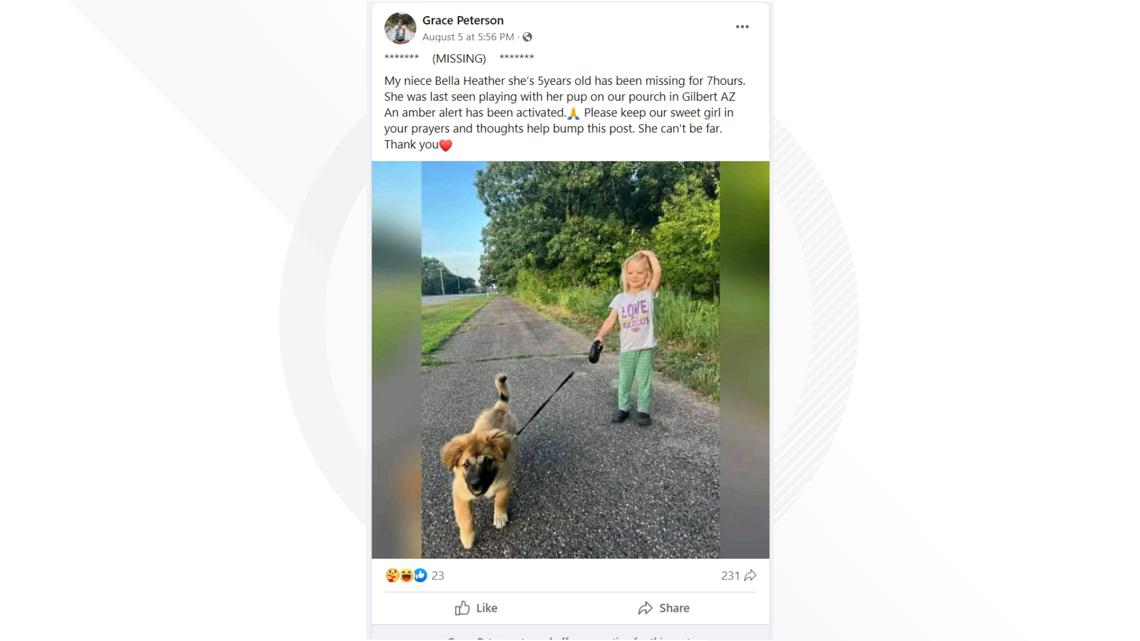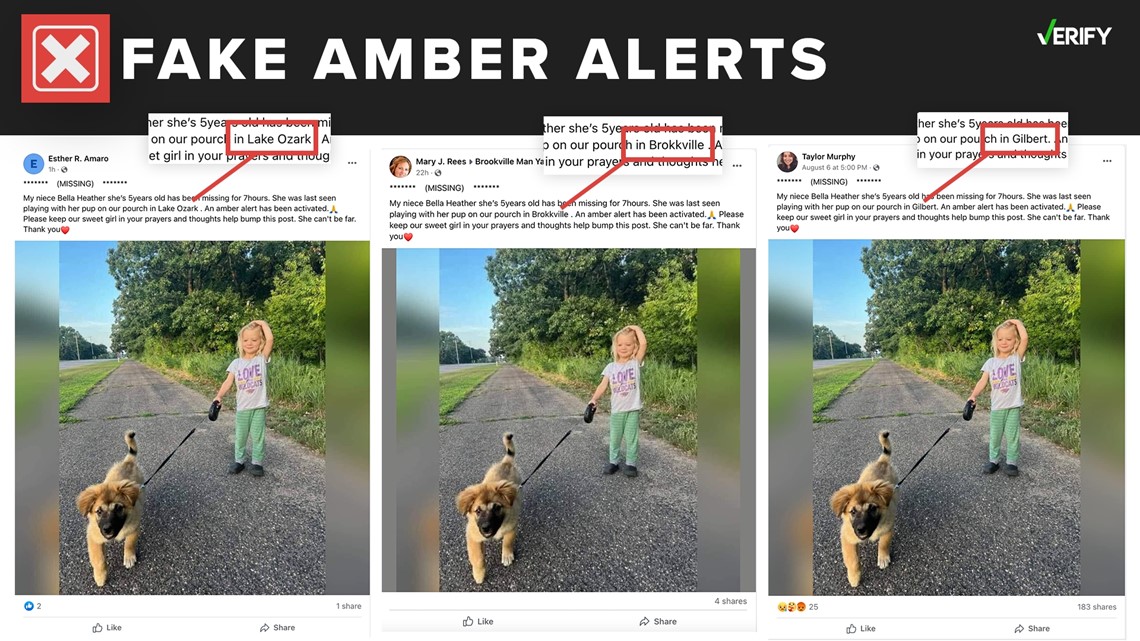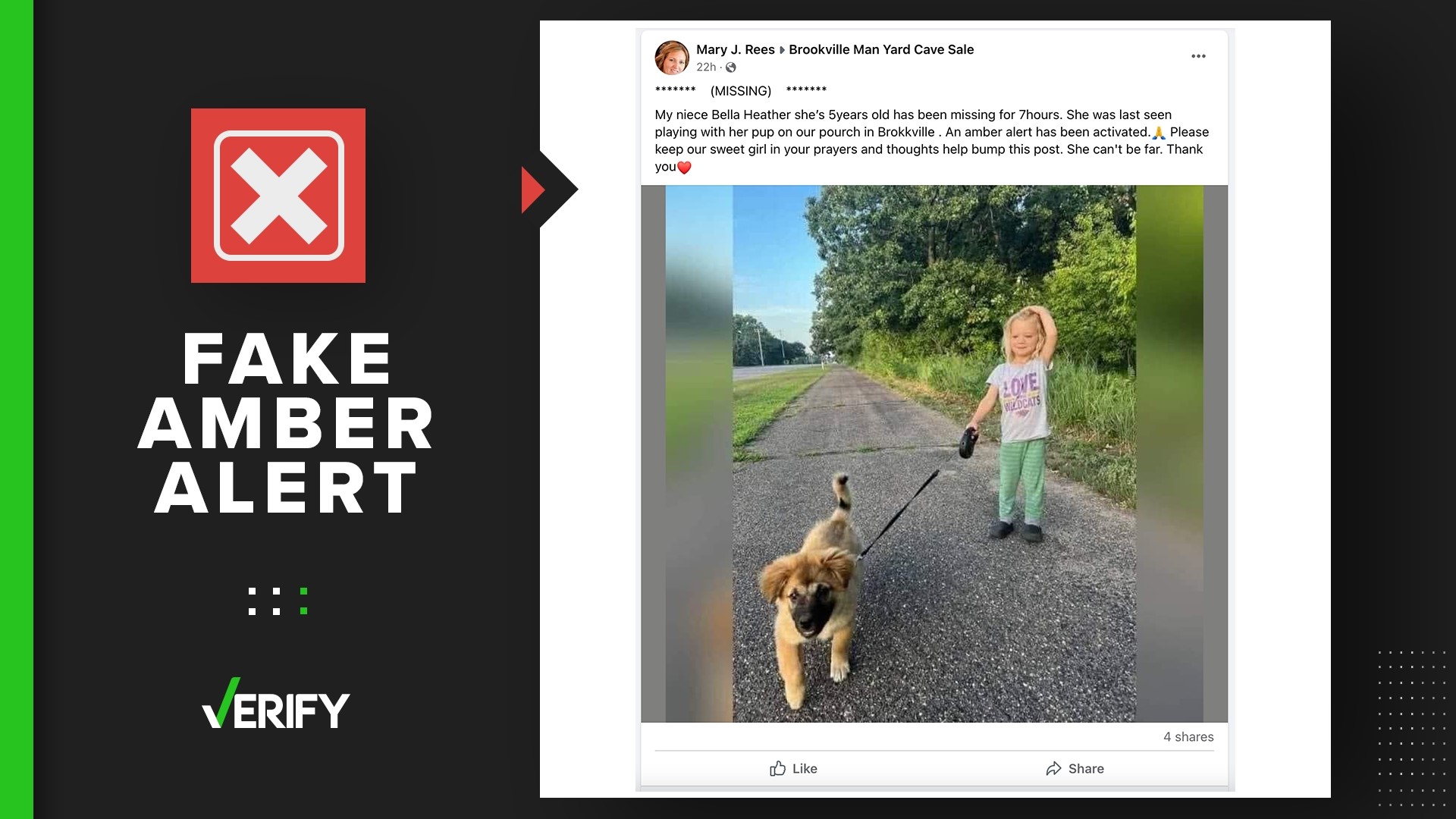Posts being shared across multiple public groups on Facebook are alerting users of an apparent active Amber Alert for a missing 5-year-old girl.
One of the first posts about the missing child appears to have been published on Aug. 5 in the Facebook group called Buy & Sell Gilbert AZ. The post says Bella Heather, a little girl seen holding onto her dog’s leash in a photo, had been missing for seven hours and an Amber Alert had been activated.


“My niece Bella Heather she’s 5years old has been missing for 7hours… She was last seen playing with her pup on our pourch [sic] in Tazewell .. An amber alert has been activated.. Please keep our sweet girl in your prayers and thoughts help bump this post.. She can't be far. Thank you,” one of the posts says.
VERIFY did a keyword search on Facebook of the text in the caption and found variations of the post published multiple times across several different buy-and-sell groups. In nearly each post, the content is identical but the town name has been changed.
A VERIFY viewer reached out to ask if these posts are actually about a real missing girl.
THE QUESTION
Are the Facebook posts about a missing 5-year-old named Bella Heather real?
THE SOURCES
- RevEye, a reverse image search tool
- National Center for Missing & Exploited Children (NCMEC)
- Officer Levi Leyba, the public information officer at the Gilbert (Arizona) Police Department
- Better Business Bureau
THE ANSWER
No, the Amber Alert social media posts about 5-year-old Bella Heather aren’t real. The image was likely created using generative artificial intelligence.
WHAT WE FOUND
The National Center for Missing & Exploited Children (NCMEC) keeps track of missing children and posts active Amber Alerts on its website.
There are no current active Amber Alerts on the website for anyone named Bella Heather, and there has never been an Amber Alert issued for a child by that name.
VERIFY used RevEye, a reverse image search engine, to search for any instances of the photo seen in the viral Facebook posts. We did not find the image used in any official missing person reports from law enforcement or news outlets. In fact, we did not find the image anywhere else on the internet.
Upon closer examination, VERIFY found the image was likely created with generative artificial intelligence (AI), or a program that creates new content based on a submitted prompt.
AI image generators often struggle to create realistic representations of fingers and hands. If you look at the girl’s hand holding the leash, you can see that her fingers and hand are misshapen and awkward.
AI also has difficulty with different textures and other small details. The dog’s front right leg appears to be missing the definition of a paw; the tail and facial markings are also mismatched in color and the texture of the fur appears animated.
All of the posts VERIFY found also contain nearly identical text, including spelling and grammatical errors, but the town name is different.


For example, this post says, “My niece Bella Heather she’s 5years old has been missing for 7hours… She was last seen playing with her pup on our pourch in Tazewell .. An amber alert has been activated.. Please keep our sweet girl in your prayers and thoughts help bump this post.. She can't be far. Thank you”
But this post says, “My niece Bella Heather she’s 5years old has been missing for 7hours. She was last seen playing with her pup on our pourch in Gilbert AZ. An amber alert has been activated. Please keep our sweet girl in your prayers and thoughts help bump this post. She can't be far. Thank you.”
One of the cities listed is Gilbert, Arizona. In an email to VERIFY, Gilbert Police Officer Levi Leyba said, “This appears to be a scam circulating social media. We do not have an Amber Alert for her.” Other cities listed on the Facebook posts have also not publicized an active Amber Alert for a girl with that name.
According to the Better Business Bureau, these types of posts are a “certain kind of attention-grabbing post [that] might put their friends at risk of falling victim to a scam.”
“You are scrolling through Facebook, and a gut-wrenching post about an injured, lost pet or a missing child grabs your attention. You want to help, so you share the post on your own profile.
After you share the post, a scammer changes the original post to a deceptive rental ad or sometimes to a link pointing to a survey that ‘guarantees’ a cash prize. Now, your friends think you have recommended that content. These bait-and-switch ads aim to either get a deposit for a rental property before the user gets a chance to see the home- or get your personal information, which could lead to identity theft,” the BBB says.
One Facebook post appearing to be written by someone named Miriam James did get edited, just like the BBB warned. According to the Facebook edit history on the post, it was published at 3:37 a.m. on Aug. 7 and was originally about the missing girl. That same day at 8:49 p.m., the post was edited to be about a single-family home for rent and includes a link to a scam website.
Something similar happened on a Facebook post from someone named Ashley Waynes. When VERIFY looked at the edit history, the Aug.6 post originally was the Amber Alert warning. On Aug. 8, it was edited to a post about her grandparents that were urgently looking for a family to occupy a vacant home.
The BBB offered these tips to avoid falling victim to a bait-and-switch scam:
- Read the information carefully and look at the profile of the person who created and shared the original post. When VERIFY looked into the people posting about the missing girl, most of the accounts are newly created (like this one) and are not profiles, but pages for health and beauty. This one says the profile is a page for a grocery store.
- You should see it in the news. If a child goes missing or a tragedy occurs, you'll most likely see it on different news outlets or shared by law enforcement, not on a random post.
- Do a reverse image search on Google. That will allow you to find out if the pictures you saw were used on other ads or websites in different cities. VERIFY did that same thing and this was a red flag because the image doesn’t exist anywhere else on the internet.
- Find similar posts. Copy and paste the text from the post into Facebook's search tool to see if other posts with the same text and different pictures show up. This is how VERIFY was able to find the multiple posts with the same content and show it’s likely part of a larger scam network.

